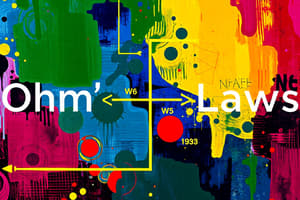Podcast
Questions and Answers
What is the fundamental principle of Kirchhoff's Current Law?
What is the fundamental principle of Kirchhoff's Current Law?
- The current at a node is equal to the sum of the currents of all the circuit elements.
- The voltage at a node is equal to the sum of the voltage drops across the circuit elements.
- The sum of all currents entering a node is equal to the sum of all currents leaving a node. (correct)
- The sum of all currents in a circuit is equal to zero.
What is the mathematical representation of Kirchhoff's Voltage Law?
What is the mathematical representation of Kirchhoff's Voltage Law?
- ΣV = ΣI
- ΣI_in = ΣI_out
- ΣΔV = 0 (correct)
- ΣI = ΣV
Where does Kirchhoff's Current Law apply?
Where does Kirchhoff's Current Law apply?
- At any node in a circuit. (correct)
- Only at the load of the circuit.
- Only at the ground of the circuit.
- Only at the source of the circuit.
What is the main purpose of using Kirchhoff's Voltage Law?
What is the main purpose of using Kirchhoff's Voltage Law?
What is a node in a circuit?
What is a node in a circuit?
Flashcards are hidden until you start studying
Study Notes
Kirchhoff's Laws
Kirchhoff's Current Law (KCL)
- States that the sum of all currents entering a node in a circuit is equal to the sum of all currents leaving a node
- Mathematically represented as: ΣI_in = ΣI_out
- Applies to any node in a circuit, where a node is a point where two or more circuit elements meet
- Useful for analyzing complex circuits and determining the current at any point in the circuit
Kirchhoff's Voltage Law (KVL)
- States that the sum of voltage changes around a closed loop in a circuit is equal to zero
- Mathematically represented as: ΣΔV = 0
- Applies to any closed loop in a circuit, allowing for the calculation of voltage drops across circuit elements
- Useful for analyzing circuits with multiple voltage sources and determining the voltage at any point in the circuit
Studying That Suits You
Use AI to generate personalized quizzes and flashcards to suit your learning preferences.




